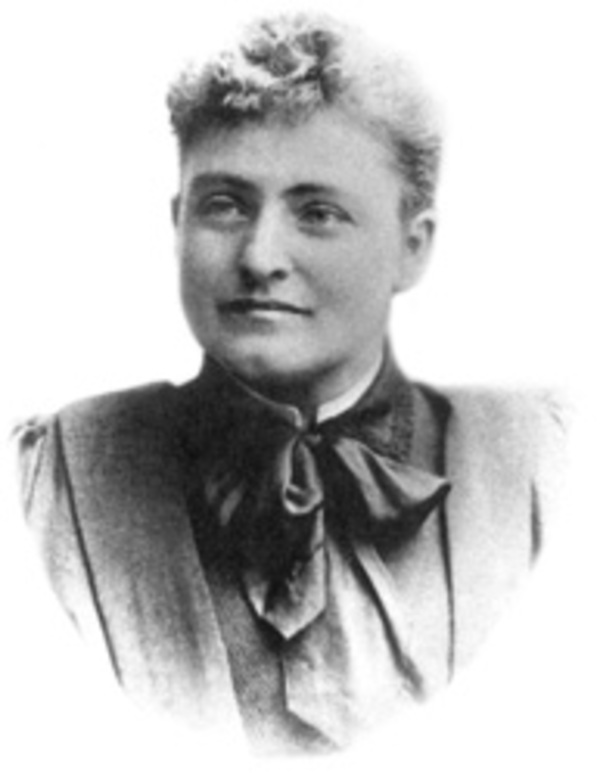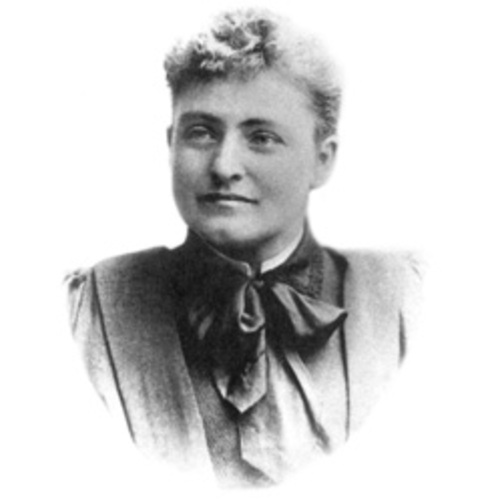
Source: Link
IRWIN, CAROLINE LOUISA JOSEPHINE (Wells), homemaker and dentist; b. 5 Aug. 1856 in Aurora, Upper Canada, daughter of Charles Irwin and Catharine (Catherine) Tyson; m. there 7 March 1877 John Wells, and they had two daughters and three sons; d. 17 March 1939 in Toronto and was buried in Aurora, Ont.
Josephine Wells was the first woman licensed in the profession of dentistry in Ontario, and one of the first in Canada, and she was a Canadian pioneer of dental care in mental hospitals. She had a career in both private practice and institutional settings for approximately 35 years. As was the case for many women of her time, her life had been fundamentally shaped by her family ties; it was her roles as a wife and mother that led her to become a path-breaker for women in dentistry.
The eldest of six children in a family that originally adhered to the New Connexion Methodist Church but later joined the Disciples of Christ, Irwin grew up in Aurora, where her father worked as a miller. According to the records of the Royal College of Dental Surgeons of Ontario [see Barnabas W. Day*], she received “a good public school education in her youth.” In 1877, at the age of 20, she married a local farmer, 24-year old John Wells, who shared her Disciples faith. Within a few years, John, who had left farming for teaching, was enrolled at the School of Dentistry in Toronto, run by the RCDS; he graduated at the top of his class in 1882. At the time Josephine was busy with their growing family: daughter Mabel had been born in 1880 and son Charles Pearson the following year; Arthur Tyson would follow in 1883 (he was to die the month after his birth) and Edith Muriel in 1884. After graduation, John practised his profession in Meaford and then in Aurora.
Around 1889 the Wellses moved to Toronto, where John opened an office in their home. His health declined, and it soon became clear he could not sustain the business and support the family on his own. John and Josephine contacted members of the Ontario dentists’ regulatory board to seek her entry to its school. The hope was that she could join or perhaps take over John’s practice. Although it was not uncommon for wives to assist their dentist husbands by fulfilling various support duties, Josephine appears (like some others) to have done more: in her petition for admission in 1891 she stated, the board noted, “that for some years she has performed most of the work in the office.” She asked that she be accepted despite the absence of “any Certificate of Qualification that would admit her to Matriculation.”
Wells seems to have been the first woman to seek admission at the school. While the entry of women such as Emily Howard Jennings* Stowe and Jenny Kidd Gowanlock* Trout into medicine in the 1860s and 1870s had met with considerable opposition, as was Clara Brett Martin*’s acceptance into the legal profession in the early 1890s, there is no record of any controversy over Josephine’s application to study dentistry. She would later comment on the support she had received from James Branston Willmott*, the head of the school, and say that she had encountered “nothing else but kindness and help and encouragement from everybody.” The school’s leaders were willing to assist John Wells – their friend, colleague, and former star student – in his time of need. The board agreed in March 1891 to grant Josephine matriculation, and she was officially apprenticed to her husband. During her two years at the school, she relied on relatives and friends to help care for her three young children.
In the final examinations Wells did well in practical dentistry, probably because of her experience in her husband’s office, but given her limited education in science she found the other courses a challenge. Nevertheless, after taking supplementary tests, she completed the dental program in the fall of 1893, obtained her licence on 20 October, and began treating patients in the family home. Two years later she was unanimously welcomed into the Ontario Dental Society. In recognition of her status as “the first lady dentist on our list,” she was elected an honorary member with voting privileges, a move on the part of her male colleagues, who strove to be “gentlemen,” that was perhaps designed to save her the cost of the regular fees. In the 1930s she would recall that while practising in Toronto she worked also in Aurora, Woodbridge, King (King City), and Maple, devoting a day a month to each place. “It was,” she said, “a stern struggle – but I kept our home together and really enjoyed the work I had taken up.”
Wells passed the examinations to obtain her dds degree from Trinity College in 1899, a year after the death of her younger daughter. She then took a break from her career with the birth of her fifth child, Dalton Courtright, in 1900. In 1903 she published a brief paper on the care of children’s teeth that she had read before the Toronto Dental Society. After John’s death from heart failure the following year, she continued to offer dental services out of her house at College and Spadina avenues, then on Bathurst Street, and later on Boustead Avenue.
Following in the footsteps of such pioneers of public dental health as John Gennings Curtis Adams*, Wells soon became interested in providing dental services to the underprivileged and institutionalized. In the early 1900s she began working in provincial institutions, at first part-time, providing care to patients in mental hospitals in Toronto, Mimico, Orillia, and Hamilton, as well as to inmates of the Andrew Mercer Ontario Reformatory for Females and the Alexandra School for Girls, both in Toronto. In her sixties she closed her private practice and focused on her hospital work; at some point she was made head of dental services for all provincial hospitals in Ontario. She retired in 1928, at the age of 72, although she would remain connected with her colleagues and especially with other women dentists until her death on 17 March 1939. Asked in 1937 about “the secret of youth at four-score years and one,” she replied, “I’m not taken in … by all that nonsense about my youth. But, even so, I’ll give you my opinion: the way to keep young … is to keep busy and to think of others.”
Not only was Josephine Wells the first woman licensed to practise dentistry in Ontario and a founder of mental-hospital dentistry in Canada, but she was also the first Canadian woman to publish in a dental journal and likely the first to earn a dds degree. Although few women followed her into dental practice immediately (just four others entered the profession in Ontario prior to 1910), she led the way in this field. Dentistry was not an easy career for women in the late 19th and early 20th centuries. The profession was viewed as inappropriate for them at the time and patients were therefore scarce. Moreover, the high cost of establishing and maintaining a private practice, given the specialized equipment, furniture, and tools required, limited women’s involvement and forced even the most persistent to form partnerships with male dentists or share office space with them, as Wells herself did for a time. These difficulties make Wells’s achievements truly remarkable. Also among her accomplishments must be counted her children: of the three who survived to adulthood, Mabel worked as a teacher before her marriage; Charles Pearson was in the employ of the federal Post Office Department for 50 years; and Dalton Courtright became a lawyer and chief justice of the Supreme Court of Ontario.
Writing as Josephine Wells, Caroline Louisa Josephine Irwin published “Don’ts on children’s teeth,” Dominion Dental Journal (Toronto), 15 (1903): 360.
AO, RG 22-305, no.88081; RG 80-5-0-70, no.12455; RG 80-8-0-300, no.31310. UTARMS, A1973-0026 (Univ. of Toronto, dept. of graduate records), box 505, file 27 (Wells’s clippings); A1982-0003 (Univ. of Toronto, faculty of dentistry), box 002 (minutes of the board), pp.290–91, 350, 371, 387; box 009 (student and licentiate reg. (1868–1924)). “‘Be busy, think of others’: young octogenarian’s tip,” Toronto Daily Star, 5 June 1937: 18. “First woman dentist dies,” Globe and Mail, 18 March 1939: 4. “First woman to get dental degree dies,” Toronto Daily Star, 18 March 1939: 30. T. L. Adams, A dentist and a gentleman: gender and the rise of dentistry in Ontario (Toronto, 2000). D. W. Gullett, A history of dentistry in Canada (Toronto, 1971). Royal College of Dental Surgeons of Ont., Dispatch anniversary issue … (Toronto, 1993).
Cite This Article
Tracey L. Adams, “IRWIN, CAROLINE LOUISE JOSEPHINE (Wells),” in Dictionary of Canadian Biography, vol. 16, University of Toronto/Université Laval, 2003–, accessed December 30, 2025, https://www.biographi.ca/en/bio/irwin_caroline_louisa_josephine_16E.html.
The citation above shows the format for footnotes and endnotes according to the Chicago manual of style (16th edition). Information to be used in other citation formats:
| Permalink: | https://www.biographi.ca/en/bio/irwin_caroline_louisa_josephine_16E.html |
| Author of Article: | Tracey L. Adams |
| Title of Article: | IRWIN, CAROLINE LOUISE JOSEPHINE (Wells) |
| Publication Name: | Dictionary of Canadian Biography, vol. 16 |
| Publisher: | University of Toronto/Université Laval |
| Year of publication: | 2018 |
| Year of revision: | 2018 |
| Access Date: | December 30, 2025 |



